2012 Peugeot 3008 Hybrid 4 steering
[x] Cancel search: steeringPage 161 of 284

D
R
159
The gearbox is then operating in auto-
active mode, without any action on the
part of the driver. It continuously selects
the most suitable gear in relation to the
following parameters:
- style of driving,
- profi le of the road.
AUTO
and the gear engaged
appear in the instrument panel
screen.
Automated mode
�)
Following use of the sequential
mode, select position A
to return to
the automatic mode.
"Auto sequential" mode
This mode enables you to overtake, for
example, remaining in automatic mode
while using the functions of the sequential
mode.
�)
Operate the "+
"
or "-"
steering
mounted paddle.
The gearbox engages the gear requested
if the engine speed permits. AUTO
is still
displayed in the instrument panel.
After a few moments without any action
on the controls, the gearbox resumes
automatic control of the gears.
On sharp acceleration, the gear-
box will not change up unless the
driver acts on the gear selector
or the steering mounted paddles.
Never select neutral N
while the vehicle
is moving.
Only engage reverse gear R
when
the vehicle is immobilised with the
brake pedal pressed.
For optimum acceleration, for ex-
ample when overtaking another
vehicle, press the acce-lerator
pedal fi rmly past the point of resistance.
Page 168 of 284
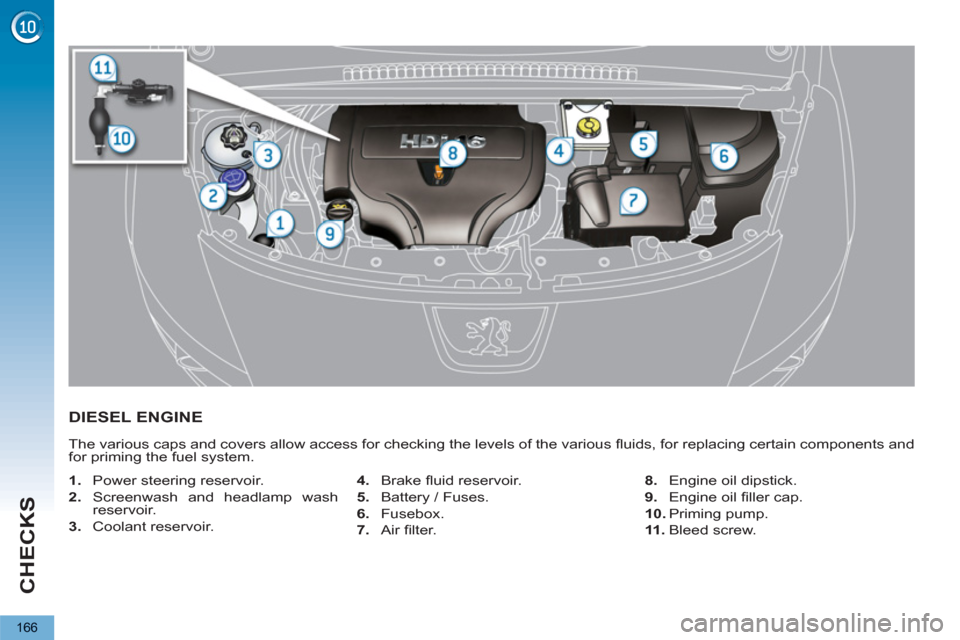
CHECKS
166
DIESEL ENGINE
The various caps and covers allow access for checking the levels of the various fl uids, for replacing certain components and
for priming the fuel system.
1.
Power steering reservoir.
2.
Screenwash and headlamp wash
reservoir.
3.
Coolant reservoir.
4.
Brake fl uid reservoir.
5.
Battery / Fuses.
6.
Fusebox.
7.
Air fi lter.
8.
Engine oil dipstick.
9.
Engine oil fi ller cap.
10.
Priming pump.
11 .
Bleed screw.
Page 169 of 284
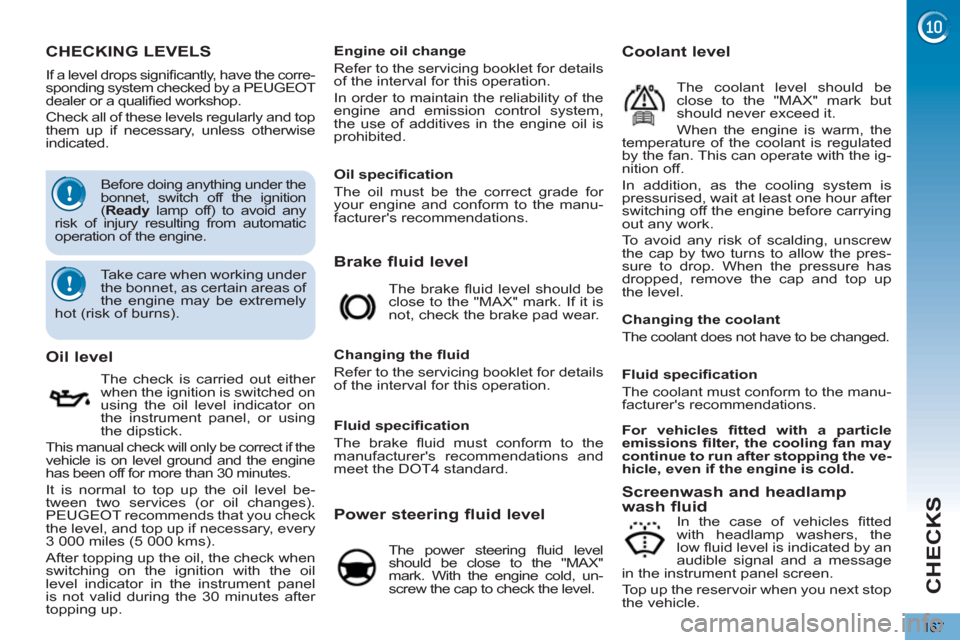
CHECKS
167
CHECKING LEVELS
Oil level
The check is carried out either
when the ignition is switched on
using the oil level indicator on
the instrument panel, or using
the dipstick.
This manual check will only be correct if the
vehicle is on level ground and the engine
has been off for more than 30 minutes.
It is normal to top up the oil level be-
tween two services (or oil changes).
PEUGEOT recommends that you check
the level, and top up if necessary, every
3 000 miles (5 000 kms).
After topping up the oil, the check when
switching on the ignition with the oil
level indicator in the instrument panel
is not valid during the 30 minutes after
topping up.
Take care when working under
the bonnet, as certain areas of
the engine may be extremely
hot (risk of burns).
Before doing anything under the
bonnet, switch off the ignition
( Ready
lamp off) to avoid any
risk of injury resulting from automatic
operation of the engine.
If a level drops signifi cantly, have the corre-
sponding system checked by a PEUGEOT
dealer or a qualifi ed workshop.
Check all of these levels regularly and top
them up if necessary, unless otherwise
indicated.
Engine oil change
Refer to the servicing booklet for details
of the interval for this operation.
In order to maintain the reliability of the
engine and emission control system,
the use of additives in the engine oil is
prohibited.
Oil specifi cation
The oil must be the correct grade for
your engine and conform to the manu-
facturer's recommendations.
Brake fluid level
The brake fl uid level should be
close to the "MAX" mark. If it is
not, check the brake pad wear.
Changing the fl uid
Refer to the servicing booklet for details
of the interval for this operation.
Fluid specifi cation
The brake fl uid must conform to the
manufacturer's recommendations and
meet the DOT4 standard.
Power steering fluid level
The power steering fl uid level
should be close to the "MAX"
mark. With the engine cold, un-
screw the cap to check the level.
Coolant level
The coolant level should be
close to the "MAX" mark but
should never exceed it.
When the engine is warm, the
temperature of the coolant is regulated
by the fan. This can operate with the ig-
nition off.
In addition, as the cooling system is
pressurised, wait at least one hour after
switching off the engine before carrying
out any work.
To avoid any risk of scalding, unscrew
the cap by two turns to allow the pres-
sure to drop. When the pressure has
dropped, remove the cap and top up
the level.
Changing the coolant
The coolant does not have to be changed.
Fluid specifi cation
The coolant must conform to the manu-
facturer's recommendations.
For vehicles fi tted with a particle
emissions fi lter, the cooling fan may
continue to run after stopping the ve-
hicle, even if the engine is cold.
Screenwash and headlamp
wash fluid
In the case of vehicles fi tted
with headlamp washers, the
low fl uid level is indicated by an
audible signal and a message
in the instrument panel screen.
Top up the reservoir when you next stop
the vehicle.
Page 173 of 284
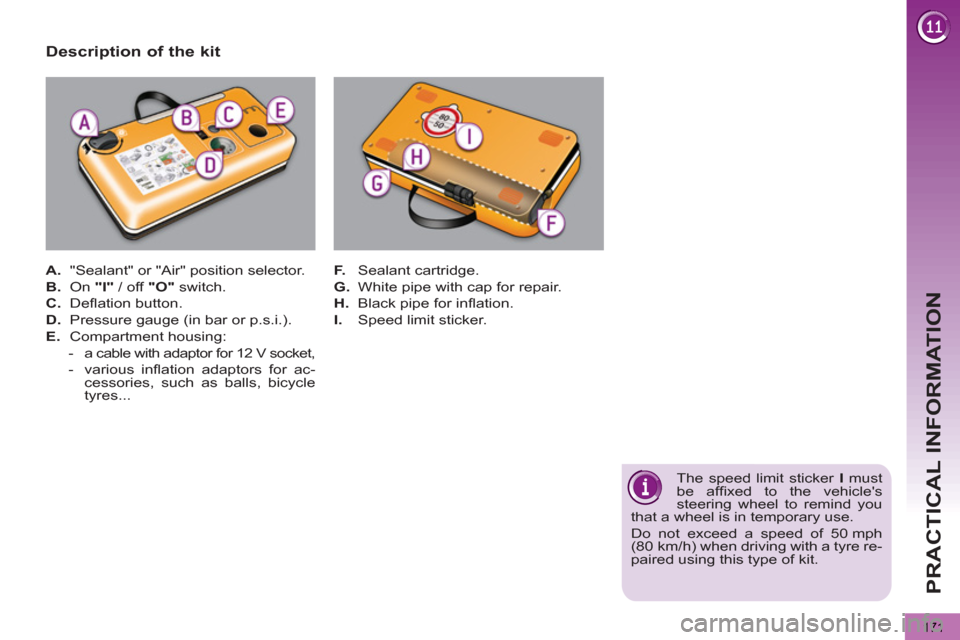
PRACTICAL INFORMATION
171
The speed limit sticker I
must
be affi xed to the vehicle's
steering wheel to remind you
that a wheel is in temporary use.
Do not exceed a speed of 50 mph
(80 km/h) when driving with a tyre re-
paired using this type of kit.
A.
"Sealant" or "Air" position selector.
B.
On "I"
/ off "O"
switch.
C.
Defl ation button.
D.
Pressure gauge (in bar or p.s.i.).
E.
Compartment housing:
- a cable with adaptor for 12 V socket,
- various infl ation adaptors for ac-
cessories, such as balls, bicycle
tyres...
Description of the kit
F.
Sealant cartridge.
G.
White pipe with cap for repair.
H.
Black pipe for infl ation.
I.
Speed limit sticker.
Page 187 of 284
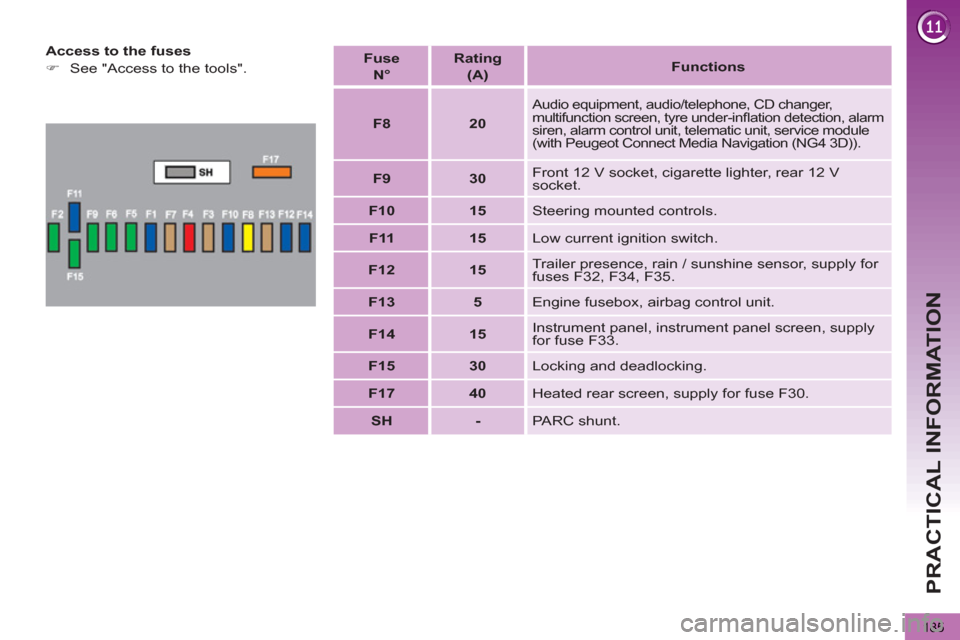
PRACTICAL INFORMATION
185
Access to the fuses
�)
See "Access to the tools".
Fuse
N°
Rating
(A)
Functions
F8
20
Audio equipment, audio/telephone, CD changer,
multifunction screen, tyre under-infl ation detection, alarm
siren, alarm control unit, telematic unit, service module
(with Peugeot Connect Media Navigation (NG4 3D)).
F9
30
Front 12 V socket, cigarette lighter, rear 12 V
socket.
F10
15
Steering mounted controls.
F11
15
Low current ignition switch.
F12
15
Trailer presence, rain / sunshine sensor, supply for
fuses F32, F34, F35.
F13
5
Engine fusebox, airbag control unit.
F14
15
Instrument panel, instrument panel screen, supply
for fuse F33.
F15
30
Locking and deadlocking.
F17
40
Heated rear screen, supply for fuse F30.
SH
-
PARC shunt.
Page 189 of 284
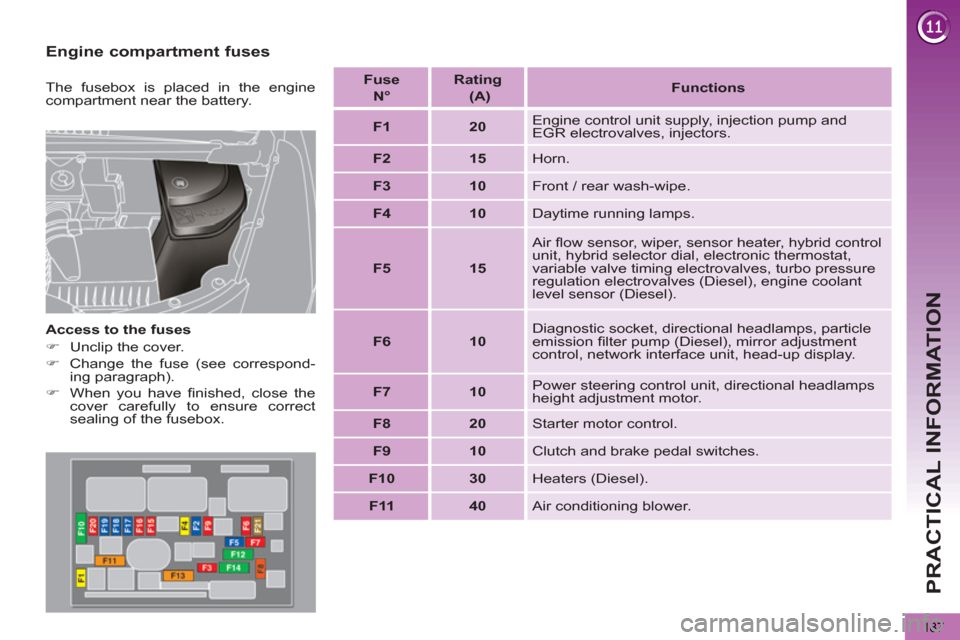
PRACTICAL INFORMATION
187
Engine compartment fuses
Access to the fuses
�)
Unclip the cover.
�)
Change the fuse (see correspond-
ing paragraph).
�)
When you have fi nished, close the
cover carefully to ensure correct
sealing of the fusebox.
The fusebox is placed in the engine
compartment near the battery.
Fuse
N°
Rating
(A)
Functions
F1
20
Engine control unit supply, injection pump and
EGR electrovalves, injectors.
F2
15
Horn.
F3
10
Front / rear wash-wipe.
F4
10
Daytime running lamps.
F5
15
Air fl ow sensor, wiper, sensor heater, hybrid control
unit, hybrid selector dial, electronic thermostat,
variable valve timing electrovalves, turbo pressure
regulation electrovalves (Diesel), engine coolant
level sensor (Diesel).
F6
10
Diagnostic socket, directional headlamps, particle
emission fi lter pump (Diesel), mirror adjustment
control, network interface unit, head-up display.
F7
10
Power steering control unit, directional headlamps
height adjustment motor.
F8
20
Starter motor control.
F9
10
Clutch and brake pedal switches.
F10
30
Heaters (Diesel).
F11
40
Air conditioning blower.
Page 191 of 284
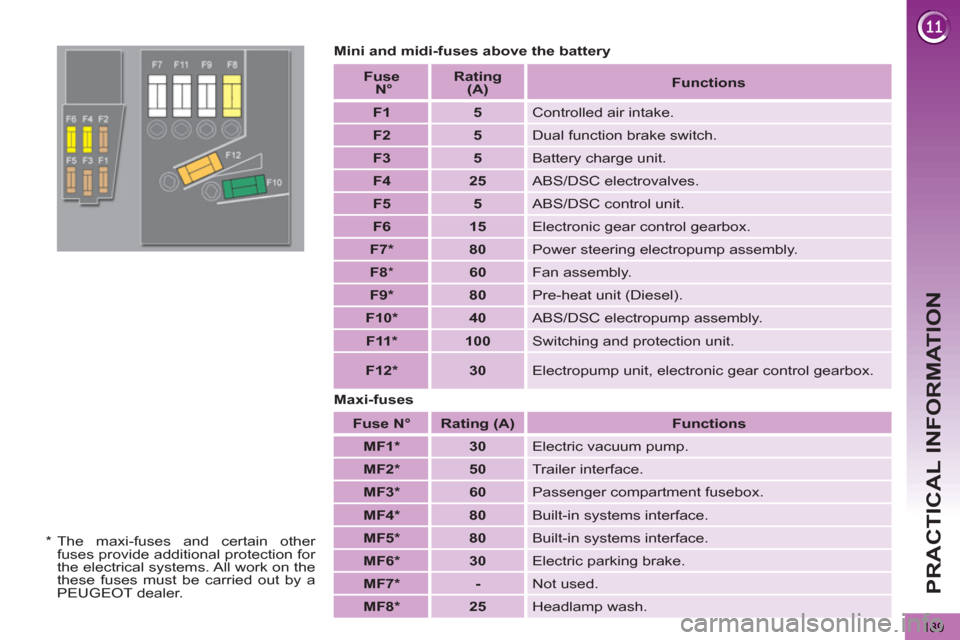
PRACTICAL INFORMATION
189
Mini and midi-fuses above the battery
Maxi-fuses
Fuse
N°
Rating
(A)
Functions
MF1 *
30
Electric vacuum pump.
MF2 *
50
Trailer interface.
MF3 *
60
Passenger compartment fusebox.
MF4 *
80
Built-in systems interface.
MF5 *
80
Built-in systems interface.
MF6 *
30
Electric parking brake.
MF7 *
-
Not used.
MF8 *
25
Headlamp wash.
Fuse
N°
Rating
(A)
Functions
F1
5
Controlled air intake.
F2
5
Dual function brake switch.
F3
5
Battery charge unit.
F4
25
ABS/DSC electrovalves.
F5
5
ABS/DSC control unit.
F6
15
Electronic gear control gearbox.
F7 *
80
Power steering electropump assembly.
F8
*
60
Fan assembly.
F9 *
80
Pre-heat unit (Diesel).
F10 *
40
ABS/DSC electropump assembly.
F11 *
100
Switching and protection unit.
F12 *
30
Electropump unit, electronic gear control gearbox.
*
The maxi-fuses and certain other
fuses provide additional protection for
the electrical systems. All work on the
these fuses must be carried out by a
PEUGEOT dealer.
Page 211 of 284
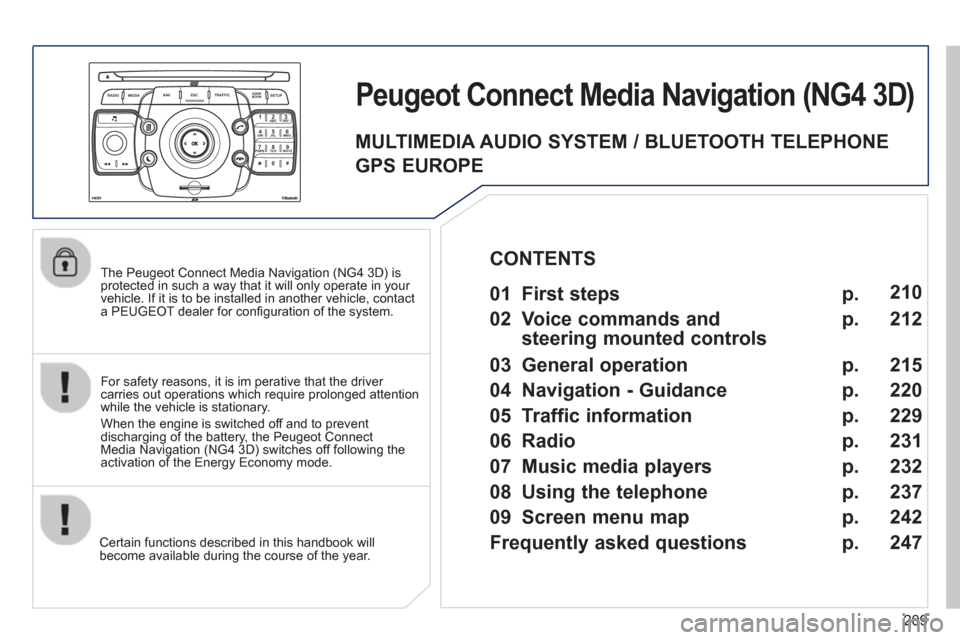
209
2ABC3DEF5JKL4GHI6MNO8TUV7PQRS9WXYZ0*#
1
RADIO MEDIANAV ESC TRAFFIC
SETUPADDR
BOOK
The Peugeot Connect Media Navigation (NG4 3D) is protected in such a way that it will only operate in your
vehicle. If it is to be installed in another vehicle, contact
a PEUGEOT dealer for confi guration of the system.
Certain functions described in this handbook will
become available during the course of the year.
Peugeot Connect Media Navigation(NG4 3D)
For safety reasons, it is im perative that the driver carries out operations which require prolonged attention
while the vehicle is stationary.
When the en
gine is switched off and to prevent
discharging of the battery, the Peugeot ConnectMedia Navigation (NG4 3D) switches off following the
activation of the Energy Economy mode.
01 First steps
02 Voice commands and
steering mounted controls
03 General operation
04 Navigation - Guidance
05 Traffic information
06 Radio
07 Music media players
08 Using the telephone
09 Screen menu map
Frequently asked questions p.
p.
p.
p.
p.
p.
p.
p.
p.
p. 210
212
2
15
220
229
231
232
2
37
242
247
CONTENTS
MULTIMEDIA AUDIO SYSTEM / BLUETOOTH TELEPHONE
GPS EUROPE